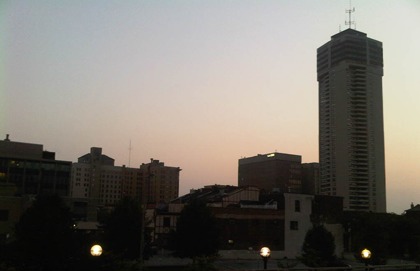A poem can be read, appreciated, even treasured, without the reader knowing the poet. This signifies in at least a trivial way that a poem is different than a poet. Darrell Epp is a poet. He writes poems. The relationship between the two is integral. Without Darrell, his poems cannot exist. Without his poems, we would not be taking time to reflect on his life as a poet. Another integral element in this mix is the place in which a poet lives and writes poems. In this case, the City of Hamilton furnishes that third member and moves our consideration from a Newtonian two-body problem for which we might readily make our calculations and the much more difficult three-body problem wherein great complexity enters.
Poetry and city building should be thought of as integral to each other but in practice that is seldom (ever?) the case.
It would be entirely uncommon for a group of urban planners or developers to give poetry a place at the table of their deliberations. In city planning, the arts are largely instrumental – they are worth considering because they generate economic value. Poetic insight does not inform deliberations or constrain bad urban design, developer greed, or reduce the sedimentary layers or bylaws, codes, and legalities.
This is not to suggest that people involved in formal city planning or development work don’t read poetry and don’t appreciate the arts. The distribution of their interests along that line are likely the same as would be found in the general populace. Art galleries, paintings and good design are nice to have and are good for tourism and recreation. Music enriches our spare time. Poetry is a nice, if somewhat unusual, hobby, and is best served as lyrics in a catchy song.
I do not subscribe to this valuation structure.
If you are serious about cities, great neighbourhoods, and dare to pursue the good life beyond materialistic cardboard dimensions, then both the poet and the poems which inhabit, grow out of, and provoke your city are a vital literacy without which we are truly impoverished.
William Carlos Williams was a writer and medical doctor. His Afterword is a compelling reflection on how various professionalized and group functions bend us toward self-referential systems, structures, and procedures that exclude other ways of thinking and seeing. The deep satisfaction and meaning that he found in his medical practice did not arise from a mechanistic repair of broken human machines, but that fleeting enormity of souls glimpsed in the midst of the human interactions often at their extremities of birth, death, dying, and healing.
This is the domain of the poet in a place, crafting poems to lead us to see, to suspend distraction, to observe the who, to grasp the what, and discern the how of all that transcends our pre-formatted, procedural lives. Consider this excerpt from Darrell Epp’s collection Sinner’s Dance:
“My Kind of Saint”
Darrell Epp
on weekends
when my head is cleared
of bureaucratic gossip
and the earth’s axis has
adjusted itself accordingly
the sun races down my street
that 3-lane 1-way commuters
treat like an expressway and
i can see all the way from
burlington to stoney creek
from the future to the past
those houses had front yards
before the expropriation
these yards were forests
throbbing with wild boar and
deer before confederation
before sir john a macdonald
kicked sir allan mcnab out
of the way in the name of
progress i once saw a man
with no shoes give his
last cigarette to a man
with fancy boots just
because the man was
shaky from loneliness….
and the naked love in
Our best urban designers and thinkers are like poets. Jan Gehl notices how living humans relate to other living humans amid the spaces of their lives. Abdoumaliq Simone challenges us to think about our “relational infrastructures” in the midst of constraining, powerful masters. Geoffrey West notices that city structures have mathematical constants. St. Louis transportation experts noted in 1930 that more roads mean more traffic demand. And, like poets, a great deal of what these people said and say goes unheeded.
The well-known Hamilton poet, John Terpstra, experienced the effects of this low-density, suburban form which arose in response to the demand for low density created by dramatic increases in personal vehicle use in cities:
“I Moved to Burlington in my Sleep”
I moved to Burlington in my sleep. I moved
upstairs, to Burlington, Master Bedroom,
down the long hallway from Hogtown. I moved,
and in my sleep it was a Sunday afternoon,
Open House. Strangers were drifting
room to room, nodding in twos
through doorways, and fondling the woodwork.
They moved across the wall to wall
as if all the earth were under their feet,
but I knew they would have to leave, I knew
that four o'clock would roll around
and they would amble back to the curb, turn,
and try to imagine bicycles on the lawn,
themselves coming and going up the drive.
They didn't know this was my dream.
And in my dream it was preordained
all this
was mine….
The interactions of professional worlds and poetic expeditions need not be so rare and awkward, though the immediate power of the former nearly always over-writes the subtlety of the later. Madhur Anand is scientist who works in theoretical ecology and has published poetry that includes, like our other considered poets, both their work and the nature of human experience amid that work. Some of Anand’s poems in her book A New Index for Predicting Catastrophes are direct selections from technical academic papers:
“The Gallery”
Was abandoned 27 years ago
Undisturbed by power, pollution,
or annual precipitation
It was based on ecological
reasoning and sensitive removal
The failure of the seeds to arrive
strengthened the canonical
Resident communities found it
Building a path
through subtropical forest,
they removed insignificant arrows
which made it less isolated
It provided relief among the small-scale
agriculture and granite outcrops
They experienced an intense range
shift in history, a five-fold decrease
in what was appropriate, a heavier
reliance on finding
All of the above text is taken from this academic paper: M. Leithead, M. Anand, L.d.S. Duarte, and V.D. Pillar, “Causal Effects of Latitude, Disturbance and Dispersal Limitation on Richness in a Recovering Temperate, Subtropical and Tropical Forest,” Journal of Vegetation Science 23, no. 2 (2012): 339-51.
In early May, I traveled with Darrell Epp to a poetry reading at the Welland Public Library. When a Hamilton poet reads poems outside the venue of origin, so to speak, a new vantage point can be gained, something of a test of the human, common resonance that a poem may invoke. This is the peculiar phenomena that the highly specific, intricately detailed poems that Epp writes leads to them being more valuable in a wider setting rather than less so.
Epp noted the attraction his poetry has had in the U.K. while on a recent tour there to read his work in person at various locations, including as a headliner at a cultural festival in Wales. As he related his experiences doing readings in many places, he observed that some areas have a much more robust experience with, and appreciation for, poetry.
Epp and I first crossed paths while at a downtown Hamilton icon, Philpott Memorial Church. When that initial crossing was amplified by an Easter dinner together followed by chance meetings at the Central Library in downtown Hamilton that we haunt mutually but distinctively, the pathway as intermittent trail mates was set.
There is always curiosity about the source of inspiration for writers and poets. In Epp’s case, he reflected on his own origins and said that “Since I could read I wanted to be a writer. I didn’t care about sports. I thought it would be fun to write since I love writers. My parents are intelligent people, but they are not readers. They couldn’t relate to that part of me. I was alone in this interest.”
He doesn’t know where this desire came from. Neither his parents nor siblings shared this impulse.
“My dream was to be surrounded by books, to stay in bed all day and just read. This caused problems, at times. My mother thought I needed more in my life. I didn’t.”
Over the course of the Welland Library reading, Epp covered a wide range of selections from his published books as well as a large portion of poems that are being worked on and considered for his upcoming book. All through his work, there are themes that you readily pick up as a reader, impressions, observations, and experiences that are deeply connected to life in Hamilton and the pop culture of the last four decades: “We are swimming in the detritus of pop culture so it is inevitable that those things show up in my poems.”
These long-developed experiences that take form in his poems are not necessarily pre-meditated: “You write a book to find out what you are fixated on. It turns out that in my upcoming book, predator drones is something I have very strong feelings about.”
Across the two hours of readings and discussion, Epp read published selections about Hamilton intersections, the Balmoral Tavern at King William and Wentworth, and looking down Cannon Street and then ventured off into the loose stack of new poems which were at various stages of completion. This uncorralled herd included “Love is Magic,” “Fragmentation Grenade,” and “Requiem for Steel.”
If you have read one of Epp’s books, or even just a few of his poems, you will not be able to walk the streets of Hamilton (or the pathways of your particular world) in quite the same way. You will see and think differently. It won’t be that you have tools suited to a more effective manipulation of the world around you. Poems are not a way to get ahead. Instead, you’ll have enlarged your capacity to live the place you find yourself in.
Is this practical for us? For our communities? Does it matter in the context of professional planners, eager developers, or the upwardly mobile? Is poetry a souvenir, like a cowboy boot keychain you bring back from a Nashville visit? I don’t think poetry can design or build the city, but poets and poems are essential for understanding what a city is and what it might be. Without this, we build or inhabit communities and cities that unfold mechanically from the status quo systems of our time.
A poem in the hands of a poet dares to challenge that unfolding as insufficient for a full human life. But the labour of writing, reading, or taking poetry seriously is long and deep.
Professionals are highly trained the well-practiced art of hiding their humanity underneath clean, smooth language and neat, orderly rules. They are taught to wear the armour of cool objectivity.
Poets are creatures of far greater courage. They are driven to, and experienced in, the art of revealing their humanity with nuclear-force, ultra-compact words evoking our softest, least armored parts.
Professionals scare me because of what they might do to me. Poets scare me because of what they might reveal about me.
While it is improbable that city planners and developers will implement poetry into their carefully prescribed deliberations, citizens like us can ill afford to overlook the potency of words that poets may impart to us. We may yet learn this ‘new’ art and if we but look, we may happily find guides and teachers close at hand.
Convivium means living together. We welcome your voice to the conversation. Do you know someone who would enjoy this article? Send it to them now. Do you have a response to something we've published? Let us know!





